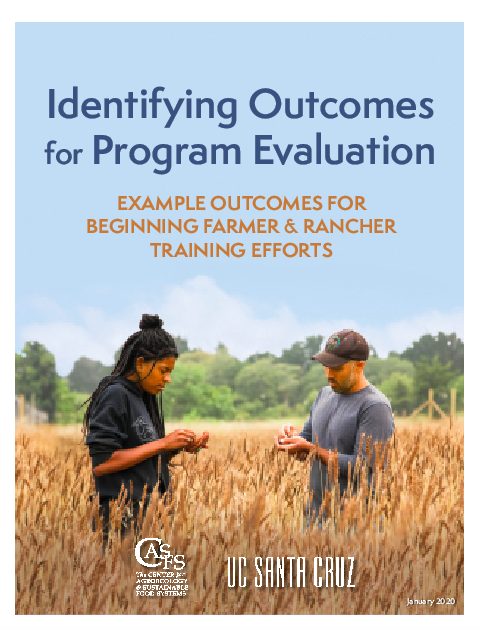Evaluation Tools
Beginning farmer and rancher (BFR) training organization staff have expressed a need for a set of useful and accessible tools to help them better develop and implement program evaluations. The following resources are designed to support BFR organizations to develop and implement evaluation activities.
Watch a 2-minute video overview of the GREW Project's evaluation tools.
Online Evaluation Resource Library
The Evaluation Resource Library provides links to the many “how to” guides available for conducting program evaluation. It also provides example surveys, reports, logic models, and similar resources from other BFR programs. These instruments can be used to help BFR training organizations develop surveys or data collections tools, design reports, etc.
The Evaluation Resource Library is hosted by the New Entry Sustainable Farming Project, and can be found at https://nesfp.org/program-evaluation/library.
Watch a 2-minute video overview of this tool.
Outcomes List—Identifying Outcomes for Program Evaluation

Click here to download the PDF.
Watch a 3-minute video overview of this tool.
Outcome Pathway Diagrams
These diagrams illustrate ways to help BFR staff think about what types of outcomes might be most useful for their organizations.
Watch a 4-minute video overview of these tools.
 Outcomes for Aspiring Farmers and Ranchers
Outcomes for Aspiring Farmers and RanchersThis diagram explores possible outcomes for organizations that train people to get started in farming and ranching. It also offers different types of “work” related outcomes, acknowledging that programs might have multiple goals when they train farmers.
 Elements of Farmer and Rancher Success
Elements of Farmer and Rancher SuccessThis diagram identifies many of the primary elements or activities that organizations can offer to support new farmer and rancher success. It also identifies several different definitions of success that might be utilized in an evaluation. By highlighting the many definitions of success, this diagram can also help BFR training staff determine which outcomes are most relevant to their organization, farmers, and funders.

This diagram identifies examples of long-term or system level outcomes that a beginning farmer and rancher program may be working towards. It can be useful for identifying long-term goals as part of planning, desired impacts for developing a theory of change or logic model, or exploring outcomes that happen beyond the individual.

This document provides an example theory of change for a hypothetical training program for aspiring farmers – highlighting the pathway the outcomes take from short-term to long-term.
See similar diagrams from current beginning farmer programs below.
- New Entry Sustainable Farming Project
- GREW Project Theory of Change
- Farm Beginnings Collaborative (coming soon!)
 BFRDP Logic Model
BFRDP Logic Model This document was developed as part of an evaluation of the USDA’s Beginning Farmer and Rancher Development Program (BFRDP).1 It highlights the many possible components that can go into programs that train beginning farmers and ranchers. This document can be used for developing logic models for evaluation or project development.
1 National Sustainable Agriculture Coalition. 2017. Cultivating the Next Generation: An Evaluation of the Beginning Farmer and Rancher Development Program (2009 to 2015). Washington D.C.
The following GREW Project advisors have provided valuable insight and contributions to the outcome pathway diagrams: Amy Bacigalupo (Land Stewardship Project); Jim Hafner (Land for Good); Tom Archibald (Virginia Tech); Pam Mavrolas (Mavrolas & Associates); Gary Matteson (Farm Credit Council); Beth Holtzman (University of Vermont Extension); Chris Brown (Agriculture & Land-Based Training Association). Additional contributions were made by Virginia State University’s Small Farm Outreach Program staff, Andrea Brown (Global Gardens), Eugenia Gusev (International Rescue Committee), Katie Painter (Global Gardens), Matthew Thorne (Organizations for Refugee and Immigrant Success). Additional thanks go to all those who supported the development of this document: Erin Foley (editor); Jane Bolling (graphic design); Stacy Philpott and Daniel Press.
